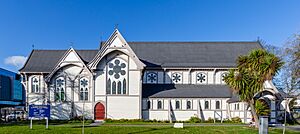Church of St Michael and All Angels, Christchurch facts for kids
Quick facts for kids Church of St Michael and All Angels |
|
|---|---|

St Michael and All Angels
|
|
| 43°32′04″S 172°37′59″E / 43.53444°S 172.63306°E | |
| Location | 84 Oxford Terrace, Christchurch Central City |
| Country | New Zealand |
| Denomination | Anglican |
| Churchmanship | Anglo-Catholic |
| History | |
| Status | Church |
| Founded | 29 September 1870 |
| Dedicated | 2 May 1872 |
| Architecture | |
| Functional status | Active |
| Heritage designation | Category I |
| Designated | 2 April 1985 |
| Architect(s) |
|
| Architectural type | Church |
| Style | Gothic Revival |
| Administration | |
| Diocese | Christchurch= |
The Church of St Michael and All Angels is an Anglican church in Christchurch, New Zealand. You can find it at 84 Oxford Terrace. This church building is very important. It is listed as a Category I heritage site by Heritage New Zealand. This means it is a place of special historical value. The church's separate bell tower is also a protected heritage site.
Contents
The Story of St Michael's Church
Early Beginnings
The church stands where the first church built by the Canterbury Association settlers once stood in 1851. Henry Jacobs led the first service there in July 1851. St Michael & All Angels was the main church for Christchurch. It served this role until the larger ChristChurch Cathedral was finished in 1881.
Building the Current Church
The person who designed the current church was William Fitzjohn Crisp. He came from England in 1864. The first stone for the church was laid on September 29, 1870. This date is known as the Feast of St Michael & All Angels. There were some issues during construction. Because of this, Frederick Strouts took over as the main architect in 1871. The church building was completed in 1872.
The church officially opened on May 2, 1872. They did not have enough money to finish the chancel (the area around the altar) until 1875. Also, the planned bell tower and spire were never built. The church is mostly made of mataī timber. It sits on strong stone foundations. It is one of the largest timber churches built in the Gothic Revival style in the Southern Hemisphere.
The Old Bell Tower
The separate belfry (bell tower) is even older than the church itself. It was designed by Benjamin Mountfort and built in 1861. The bell inside it arrived with the first ships of settlers in 1850. This bell rang every hour during the day. It helped the early settlers keep track of time.
Important People
Alfred Averill came to New Zealand in 1894. He became the vicar (leader) of St Michael and All Angels. Later, he rose to become the Archbishop of New Zealand. The church also has a school connected to it, called St Michael's Church School.
Why St Michael's is Special
The New Zealand Historic Places Trust officially listed the church as a Category I heritage building. This happened on April 2, 1985. It is important because it was the first church on the Canterbury Plains. It also served as the main church for many years. From an architectural point of view, it is special as a large timber Gothic building. The church's belfry is also a Category I heritage structure. It was registered on the same day.
Surviving Earthquakes
The wooden church building was very strong. It survived three big earthquakes in 2010 and 2011 with almost no damage. It was the only Anglican church in the central city that stayed open. The church's original plans were made with earthquakes in mind. In 1869, the church leaders decided to build with wood. They thought stone would not be strong enough after a big earthquake hit Christchurch on June 5, 1869.
In March 2011, after another major earthquake, a service was held at St Michael's. Victoria Matthews, the Bishop of Christchurch, and Kevin Rudd, Australia's Foreign Minister, attended. Mr. Rudd lit a candle to remember those who died in the February 22, 2011 earthquake.
The Church Organ
The church has a beautiful pipe organ made by Henry Bevington and Sons. It was put in place in 1873. The organ was made even bigger in 1895-1896.
The organ was damaged during the February 22, 2011 earthquake. It was taken out for repairs. A temporary organ was used while it was being fixed. This temporary organ was made from parts of instruments damaged during World War II bombings in Britain. The church raised money to help pay for the organ's restoration. The Bevington organ was put back in the church in 2013. It was even better than before, thanks to the South Island Organ Company.
Leaders of St Michael's Church
Here is a list of the vicars who have led St Michael and All Angels:
- Octavius Mathias, 1852–1860
- Henry Jacobs, 1863–1873
- Henry J. Edwards, 1873–1876
- Edward Gorton Penny, 1876–1881
- Walter Harper, 1882–1893
- Alfred Averill, 1894–1910
- Harry Darwin Burton, 1910–1915
- Charles E. Perry, 1916–1936
- Cecil Muschamp, 1937–1951
- Cecil Gault, 1951–1963
- Tim Raphael 1963–1965
- Philip Baker 1965–1986
- Ivan Smith 1986–1990
- Jonathan Kirkpatrick 1991–1996
- Peter Williams, 1997–2013
- Andrew Starky, 2013–2017
- Christopher Orczy, 2018–2022
- Jordan Greatbatch, 2023–present
Images for kids






